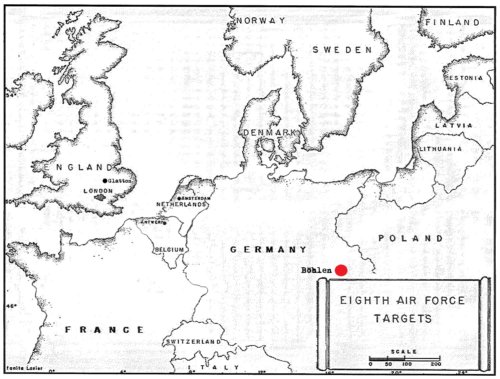TARGET: SYNTHETIC OIL PLANT
BOHLEN, GERMANY
30 NOVEMBER, 1944

Oil was again subjected to attacks by the Eighth Air Force with the synthetic oil plant at Bohlen as the primary target of the 457th. Colonel Rogner was Air Commander of the 94th Combat Wing and of the 1st Division. After Division assembly, the formation flew the route over the Continent approximately as briefed.
The turn on the IP was made about five miles south of briefed course. On the first run, the Group was unable to locate the target because of haze and smoke. The Group leader then decided to make a second run on the target and brought the formation around to the IP again. Because of mechanical difficulties incurred as the result of enemy action, the lead was turned over to the Deputy. The second run on the target was in process, when, about three fourths of the way down the bomb run, some interference was encountered from an unidentified group which was flying in a southeasterly direction toward the 457th, finally cutting in front of the fonnation. The other group then made a 180 degree turn, forcing the 45 7th off the bomb run into a left turn in order to avoid a collision.
The high squadron became separated from the lead and low squadrons, and continued on the bomb run to bomb the primary target visually. The sighting operation was hindered by a smoke screen, and the bombs were dropped about five miles southwest of Bohlen.
The lead and low squadrons, after turning off the bomb run, turned left again in search of a target of opportunity. The bombs were released on the town of Gotha, the bombs falling in the northeastern residential section of town. In the vicinity of Fulda, the two squadrons rejoined the Division and flew the remainder of the route back without further incident.
Two aircraft piloted by Lt. John W. White and Lt. Joseph C. Frechette, were lost to intense, accurate flak over the target area; however, both crash landed in France without injury to crew members. Lt. White’s craft bore the name of Hamtramack Mama.
Lt. Lauren M. Spleth was flying the lead of the high element of the high box. The aircraft took several hits on the bomb run, knocking a lot of things out, including Spleth’s right rudder pedal and the No. I propeller. Bringing the plane under control, Lt. Spleth and copilot, Lt. John F. Welch, headed the craft westward looking for friendly territory, with the airplane vibrating severely due to the windmilling No. I propeller problem, and left far behind the Group formation. Navigating by Bombigator Lt. Theodore M. Braffmann’s dead reckoning, the crew let down over Belgium and made a successful crash landing at a P-47 base near Mons, Belgium, only about 20 miles behind the front lines.
The craft piloted by Lt. James Wilson also took a direct hit. One report is that they crash landed in France. Another version says they bailed out over Belgium. Eleven craft sustained major damage and thirteen minor damage.
November ended with the Group having engaged in additional fierce combat, and having lost the most planes to enemy action for any month.
The Group now turned to December. Some were speculating the war would be over by Christmas. Two unknown and unsuspected factors would emerge in December. The winter of ’44-45 in England and on the Continent would be the fiercest in a half century, and when the weather was right the Germans were ready to launch a do or die counter offensive.
(Ed Note: For an account of the Bohlen mission by Spleth’s crew, see DEAD ENGINE KIDS.)
